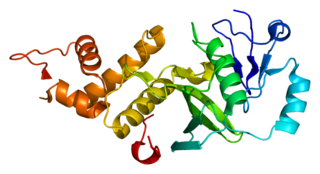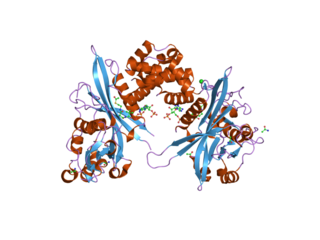K(lysine) acetyltransferase 8 (KAT8) is an enzyme that in humans is encoded by the KAT8 gene. [5] [6]
K(lysine) acetyltransferase 8 (KAT8) is an enzyme that in humans is encoded by the KAT8 gene. [5] [6]
The MYST family of histone acetyltransferases, which includes KAT8, was named for the founding members MOZ (MYST3; MIM 601408), yeast YBF2 and SAS2, and TIP60 (HTATIP; MIM 601409). All members of this family contain a MYST region of about 240 amino acids with a canonical acetyl-CoA-binding site and a C2HC-type zinc finger motif. Most MYST proteins also have a chromodomain involved in protein-protein interactions and targeting transcriptional regulators to chromatin. [6]
KAT8 is also known as MOF, and in humans hMOF. Given its fundamental role in modulating higher-order chromatin structure, hMOF is involved in many of the steps of the DNA damage response. [7] The human hMOF gene encodes an enzyme that specifically acetylates histone H4 at lysine 16. [7] [8] The depletion of hMOF greatly decreases DNA double-strand break repair by both non-homologous end joining and homologous recombination. [8] Thus MOF activity is critical for double-strand break repair. [8]

In biology, histones are highly basic proteins abundant in lysine and arginine residues that are found in eukaryotic cell nuclei and in most Archaeal phyla. They act as spools around which DNA winds to create structural units called nucleosomes. Nucleosomes in turn are wrapped into 30-nanometer fibers that form tightly packed chromatin. Histones prevent DNA from becoming tangled and protect it from DNA damage. In addition, histones play important roles in gene regulation and DNA replication. Without histones, unwound DNA in chromosomes would be very long. For example, each human cell has about 1.8 meters of DNA if completely stretched out; however, when wound about histones, this length is reduced to about 9 micrometers (0.09 mm) of 30 nm diameter chromatin fibers.

Histone acetyltransferases (HATs) are enzymes that acetylate conserved lysine amino acids on histone proteins by transferring an acetyl group from acetyl-CoA to form ε-N-acetyllysine. DNA is wrapped around histones, and, by transferring an acetyl group to the histones, genes can be turned on and off. In general, histone acetylation increases gene expression.

Histone H4 is one of the five main histone proteins involved in the structure of chromatin in eukaryotic cells. Featuring a main globular domain and a long N-terminal tail, H4 is involved with the structure of the nucleosome of the 'beads on a string' organization. Histone proteins are highly post-translationally modified. Covalently bonded modifications include acetylation and methylation of the N-terminal tails. These modifications may alter expression of genes located on DNA associated with its parent histone octamer. Histone H4 is an important protein in the structure and function of chromatin, where its sequence variants and variable modification states are thought to play a role in the dynamic and long term regulation of genes.

Histone acetyltransferase p300 also known as p300 HAT or E1A-associated protein p300 also known as EP300 or p300 is an enzyme that, in humans, is encoded by the EP300 gene. It functions as histone acetyltransferase that regulates transcription of genes via chromatin remodeling by allowing histone proteins to wrap DNA less tightly. This enzyme plays an essential role in regulating cell growth and division, prompting cells to mature and assume specialized functions (differentiate), and preventing the growth of cancerous tumors. The p300 protein appears to be critical for normal development before and after birth.

A bromodomain is an approximately 110 amino acid protein domain that recognizes acetylated lysine residues, such as those on the N-terminal tails of histones. Bromodomains, as the "readers" of lysine acetylation, are responsible in transducing the signal carried by acetylated lysine residues and translating it into various normal or abnormal phenotypes. Their affinity is higher for regions where multiple acetylation sites exist in proximity. This recognition is often a prerequisite for protein-histone association and chromatin remodeling. The domain itself adopts an all-α protein fold, a bundle of four alpha helices each separated by loop regions of variable lengths that form a hydrophobic pocket that recognizes the acetyl lysine.
The family of heterochromatin protein 1 (HP1) consists of highly conserved proteins, which have important functions in the cell nucleus. These functions include gene repression by heterochromatin formation, transcriptional activation, regulation of binding of cohesion complexes to centromeres, sequestration of genes to the nuclear periphery, transcriptional arrest, maintenance of heterochromatin integrity, gene repression at the single nucleosome level, gene repression by heterochromatization of euchromatin, and DNA repair. HP1 proteins are fundamental units of heterochromatin packaging that are enriched at the centromeres and telomeres of nearly all eukaryotic chromosomes with the notable exception of budding yeast, in which a yeast-specific silencing complex of SIR proteins serve a similar function. Members of the HP1 family are characterized by an N-terminal chromodomain and a C-terminal chromoshadow domain, separated by a hinge region. HP1 is also found at some euchromatic sites, where its binding can correlate with either gene repression or gene activation. HP1 was originally discovered by Tharappel C James and Sarah Elgin in 1986 as a factor in the phenomenon known as position effect variegation in Drosophila melanogaster.

Histone acetylation and deacetylation are the processes by which the lysine residues within the N-terminal tail protruding from the histone core of the nucleosome are acetylated and deacetylated as part of gene regulation.

Histone H4 is a protein that in humans is encoded by the HIST4H4 gene.

Histone acetyltransferase KAT2A is an enzyme that in humans is encoded by the KAT2A gene.

Histone acetyltransferase KAT5 is an enzyme that in humans is encoded by the KAT5 gene. It is also commonly identified as TIP60.

Mortality factor 4-like protein 1 is a protein that in humans is encoded by the MORF4L1 gene.

Histone acetyltransferase KAT7 is an enzyme that in humans is encoded by the KAT7 gene. It specifically acetylates H4 histones at the lysine12 residue (H4K12) and is necessary for origin licensing and DNA replication. KAT7 associates with origins of replication during G1 phase of the cell cycle through complexing with CDT1. Geminin is thought to inhibit the acetyltransferase activity of KAT7 when KAT7 and CDT1 are complexed together.

K(lysine) acetyltransferase 6A (KAT6A), is an enzyme that, in humans, is encoded by the KAT6A gene. This gene is located on human chromosome 8, band 8p11.21.

Histone H3.1 is a protein in humans that is encoded by the H3C1 gene.

K(lysine) acetyltransferase 6B (KAT6B) is an enzyme that in humans is encoded by the KAT6B gene.

JADE1 is a protein that in humans is encoded by the JADE1 gene.

Histone acetyltransferase 1, also known as HAT1, is an enzyme that, in humans, is encoded by the HAT1 gene.
Protein acetylation are acetylation reactions that occur within living cells as drug metabolism, by enzymes in the liver and other organs. Pharmaceuticals frequently employ acetylation to enable such esters to cross the blood–brain barrier, where they are deacetylated by enzymes (carboxylesterases) in a manner similar to acetylcholine. Examples of acetylated pharmaceuticals are diacetylmorphine (heroin), acetylsalicylic acid (aspirin), THC-O-acetate, and diacerein. Conversely, drugs such as isoniazid are acetylated within the liver during drug metabolism. A drug that depends on such metabolic transformations in order to act is termed a prodrug.

Peregrin also known as bromodomain and PHD finger-containing protein 1 is a protein that in humans is encoded by the BRPF1 gene located on 3p26-p25. Peregrin is a multivalent chromatin regulator that recognizes different epigenetic marks and activates three histone acetyltransferases. BRPF1 contains two PHD fingers, one bromodomain and one chromo/Tudor-related Pro-Trp-Trp-Pro (PWWP) domain.
H4K16ac is an epigenetic modification to the DNA packaging protein Histone H4. It is a mark that indicates the acetylation at the 16th lysine residue of the histone H4 protein.